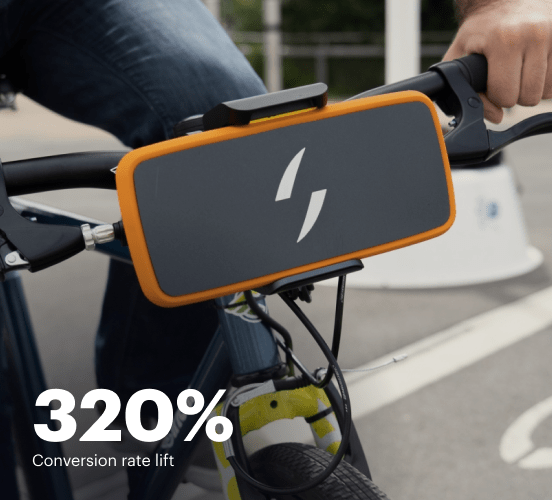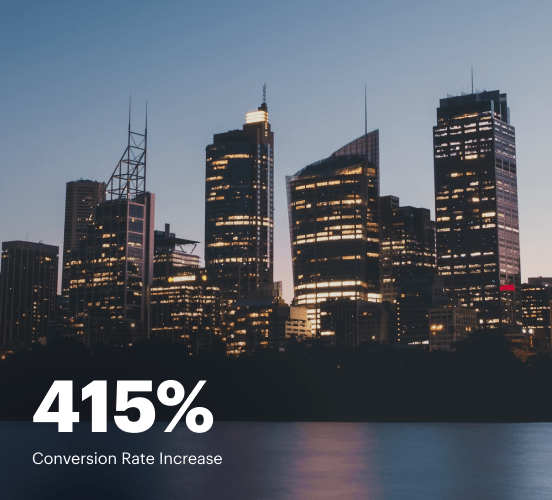How Tilda vs. Emma vs. Instapage stack up against each other
Compare Instapage with Tilda and Emma to create high-converting landing pages. With personalization, optimization, and collaboration tools, Instapage helps you deliver experiences that drive results.
Get startedSee how Instapage stacks up against the competition
| Feature | Instapage | Other builders |
| Drag-and-Drop Tools | ||
| Conversion-optimized templates | ||
| Manual and AI-powered A/B Tests | ||
| AI content suggestions | ||
| Popups and sticky bars | ||
| Canvas and grid blocks | ||
| Reusable and global elements | ||
| Form and popup builders | ||
| Built-in Heatmaps | ||
| Central analytics dashboard | ||
| Ad-to-page personalization and collections | ||
| Contacts, lists, and email | ||
| Dedicated, full-service CRO experts | ||
| Enterprise-ready platform |
Leading the way in building high-performing landing pages





Why Instapage is the smarter choice for your campaigns
Get everything you need to build, scale, and optimize high-converting landing pages—without coding.

Easier page building without coding
Instapage offers a flexible and seamless page creation experience with a library of 500+ conversion-focused layouts, Instablocks®, a drag-and-drop builder, and AI content generation. With technologies like Thor Render Engine®, you can create on-brand, mobile-responsive landing pages that load quickly and start converting during initial visitor clicks.

More insights — better results
Instapage lets you see in detail how each landing page experience and variation is performing so you can make targeted changes that boost page conversions. Use heatmaps for a better understanding of on-page activities, run A/B tests and AI-assisted experiments, and then track and evaluate results within robust analytics dashboards.

More personalized experiences
Instapage lets you quickly create high-performing landing pages tailored to each of your ad campaigns. Deliver personalized experiences for distinct audiences using dynamic text replacement. Effortlessly align specific advertisements to unique pages with AdMaps. Monitor audience-level metrics using our advanced data tools.

Built-in collaboration
Instapage collaboration capabilities bring your entire team together to speed up the process of landing page review, approval, and launch. No more frustrating and unnecessary revisions or edits scattered across emails. Provide instant feedback, conduct real-time page edits, and securely share your pages with outside stakeholders.

Free up time for your business
Invest time into business growth, not busy work. Launch landing pages faster with reusable forms and templates. Build once, reuse forever.
Explore all integrations






Easier page building without coding
Instapage offers a flexible and seamless page creation experience with a library of 500+ conversion-focused layouts, Instablocks®, a drag-and-drop builder, and AI content generation. With technologies like Thor Render Engine®, you can create on-brand, mobile-responsive landing pages that load quickly and start converting during initial visitor clicks.
More insights — better results
Instapage lets you see in detail how each landing page experience and variation is performing so you can make targeted changes that boost page conversions. Use heatmaps for a better understanding of on-page activities, run A/B tests and AI-assisted experiments, and then track and evaluate results within robust analytics dashboards.
More personalized experiences
Instapage lets you quickly create high-performing landing pages tailored to each of your ad campaigns. Deliver personalized experiences for distinct audiences using dynamic text replacement. Effortlessly align specific advertisements to unique pages with AdMaps. Monitor audience-level metrics using our advanced data tools.
Built-in collaboration
Instapage collaboration capabilities bring your entire team together to speed up the process of landing page review, approval, and launch. No more frustrating and unnecessary revisions or edits scattered across emails. Provide instant feedback, conduct real-time page edits, and securely share your pages with outside stakeholders.
Free up time for your business
Invest time into business growth, not busy work. Launch landing pages faster with reusable forms and templates. Build once, reuse forever.
Explore all integrationsGet started with Instapage in a few steps
-
Create your Instapage account
Start with Instapage by signing up via Google or your email. You'll get access to a free 14-day trial to discover Instapage capabilities. Feel free to cancel anytime during the 14-day trial if you decide that our product is not suitable for your business. -
Build and personalize your page
Create your first landing page from scratch or choose a template from 500+ customizable layouts. Use the drag-and-drop builder to add page elements, fonts, and backgrounds, refine content with AI, or add custom HTML, Javascript, and CSS. -
Review and make edits
Collaborate on page designs and streamline review processes. Invite your team members and stakeholders to review, edit, and provide feedback on your landing page. Collaborate knowing your page is confidential and only accessible to authorized users. -
Publish and track page performance
Publish your page to a domain or custom URL. Connect your pages to the ads you've created and track page performance within the analytics dashboard, run A/B tests and AI experiments, analyze results, and continuously optimize your landing page to maintain high conversions.
Instapage vs. Tilda vs. Emma – Which One Truly Excels?
Choosing the right landing page builder is akin to assembling a dream team for an epic quest—a quest to conquer conversion rates and enhance brand visibility. Much like superheroes in a blockbuster movie, each platform has its unique strengths and charm. Today, we’ll spotlight three contenders in the landing page arena: Instapage, Tilda, and Emma. Each brings its talent to the table, steering marketers towards better customer engagement and growth. As we explore their features, drawbacks, and specialties, imagine you are in a friendly competition to discover which tool might best serve your marketing endeavors. With their varying capabilities, our aim is not merely to establish a 'winner' but to guide you toward a choice that aligns perfectly with your aspirations. So, get comfortable as we unravel the intricacies of Instapage, Tilda, and Emma to uncover who stands out in the realm of landing page creation. (With insights on user experiences and highlights tailored for marketers, this comparison promises to be both enlightening and engaging.)
Meet the Players: A Brief Introduction
In the left corner, we have Instapage, the powerhouse of conversion optimization that helps marketers streamline their campaigns while delivering tailored landing page experiences. Instapage prides itself on cutting costs and amplifying conversions through its superior features. In the right corner, Tilda, a favorite among creative types, emphasizes sleek design and aesthetic appeal, giving marketers tools to create visually striking landing pages without the need for coding skills. And in the last corner stands Emma, a platform born from the need for seamless email marketing integration, making it a strong contender for those who aim to merge their landing pages effortlessly with email campaigns. Each contender champions unique talents, with their own advantages and ideal use cases. As we dive deeper into their offerings, we'll highlight what distinguishes each platform and lends to their popularity among marketers. (Prepare for a showdown that reveals how these tools cater to different needs while ultimately aiming for the same goal: boosting conversions.)
Feature Showdown: The Great Comparison
Template Variety and User-Friendly Experiences
When it comes to features, the battle begins with template variety and user-friendliness—key factors that influence user experience and efficiency. Tilda showcases an impressive library of pre-designed templates, allowing users to craft visually appealing pages that align with their brand style. The platform fosters creativity, enabling marketers to arrange blocks and create unique layouts without needing programming skills. On the other hand, Emma's templates emphasize mobile responsiveness, creating a smooth user interaction across devices. However, in terms of usability, Instapage excels by offering an intuitive drag-and-drop interface that empowers users to customize their landing pages far more freely. With a wealth of conversion-centered templates at your disposal, Instapage allows for more precise marketing targeting and tailoring of content to audience needs. Each platform has its strengths, with Tilda appealing to the design-savvy and Emma providing effective integration features. Yet, for marketers who prioritize conversion optimization blended with usability, Instapage showcases itself as an unbeatable choice. (As we absorb the nuances, consider which platform aligns best with your creative and strategic vision.)
Instapage: Champion of Customization and Conversions
Instapage shines brightly when it comes to customization options and conversion optimization tools. It provides users with unmatched flexibility, allowing for personalized touches that elevate user experiences. In addition to its extensive library of high-converting templates, the platform equips marketers with powerful A/B testing features, enabling detailed analysis of landing page performance. This ensures that every campaign can be fine-tuned and optimized based on measurable data. Moreover, Instapage empowers marketers to reduce costs, grow conversions, and deliver relevant landing page experiences that increase brand trust, customer loyalty, and conversion rates. By emphasizing straightforward integration with various marketing tools, Instapage limits the friction in workflows, making it an ideal partner in the quest for conversion success. (Whether you’re a seasoned marketer or just starting, the suite of tools provided by Instapage stands distinctively ahead as a fundamental asset.)
Speed and Performance - A Critical Consideration
As we segue into speed and performance, let's take a lighter approach. Think of website loading times as waiting in line at your favorite coffee shop—nobody enjoys it, and the longer you wait, the more likely you are to consider other options. In our fast-paced digital world, speed isn't just a luxury; it's an expectation. Landing pages that load quickly contribute significantly to user satisfaction and retention. In this round, we compare how our contenders fare in terms of performance.
Advantages of Instapage in Speed and Performance:
- Optimized for high-speed loading to minimize bounce rates
- Robust infrastructure that ensures reliability during peak traffic
- Efficient coding practices for seamless performance across devices
- Advanced settings for optimizing image sizes and content delivery
Advantages of Tilda in Speed and Performance:
- Strong emphasis on lightweight block structures for faster load times
- Built-in performance optimizations during page creation
- Responsive design elements ensure quick adjustments for various devices
Advantages of Emma in Speed and Performance:
- Integration with fast-loading email campaigns enhances overall responsiveness
- Streamlined design focuses on performance to boost user engagement
- Consistent updates to ensure optimal performance metrics
In this vital round focused on speed and performance, all three platforms present strong capabilities. However, given Instapage's robust infrastructure specifically designed for high traffic and its emphasis on fast loading, it solidifies its status as the frontrunner in this aspect.
Navigating Usability and Learning Curves
As we reach the usability and learning curve segment, we're reminded of the importance of user experience in any software. Each platform works to invite newcomers while accommodating experts. Tilda often charms users with its visually oriented interface, making it approachable for creatives with minimal tech experience. However, some users might find advanced features less intuitive. Emma, while rooted in email integration, is straightforward with its tools, easing the journey for those combining landing pages with email strategies. Instapage stands out with its in-depth onboarding processes, complete with guides and tutorials that empower new users to become impactful marketers effortlessly. This unique feature ensures that whether you're crafting your first landing page or refining your strategies, each platform creates an accessible pathway toward expertise. (Feel reassured that regardless of entry point, the journey with any of these platforms can lead to significant learning and growth.)
The Support Crew: We're Here for You
Now let's discuss customer support as the often unsung hero of any platform. Instapage offers comprehensive support options, including live chat, email assistance, and an extensive knowledge base filled with helpful resources. Additionally, it fosters a supportive community where users can exchange ideas and solutions. Tilda provides decent support but is often centered around email inquiries, which can sometimes lead to slower responses. Emma takes pride in responsive support channels and offers dedicated help for users integrating its tools into their email marketing campaigns, ensuring their needs are met promptly. A reliable support squad enhances the overall user experience, and it’s essential to consider the availability and type of assistance each platform offers in your decision-making process. (Support can make or break your success, so aligning with a platform that prioritizes customer care is paramount.)
Crunching the Numbers: Pricing Structures
As we wrap things up with a look at pricing structures, let's focus on what you get versus what you spend on each platform. Instapage operates with a premium pricing model, reflecting its extensive features and high-quality benefits. Many users find the cost justified, given the returns on investment they can achieve through improved conversion rates. Tilda provides flexible pricing tiers that cater to both budget-conscious users and more serious marketers seeking comprehensive tools. Emma typically exhibits competitive pricing with its value driven towards email marketing integration. While all three platforms offer unique value propositions, the answer lies in what aligns best with your marketing vision and budget constraints. (Take some time to evaluate these offers; the perfect fit may just have the attributes that matter most to you.)
In conclusion, choosing between Instapage, Tilda, and Emma hinges on various factors that align with your individual marketing needs. While each platform boasts its unique strengths, Instapage stands out for its customization capabilities, conversion optimization focus, and robust support system. As you navigate this decision-making process, take advantage of free trials or demos that allow you to experience the platforms firsthand. After all, discovering the right tool often involves testing how each feels for you. May your choice lead to enhanced targeting, engagement, and soaring conversions!










